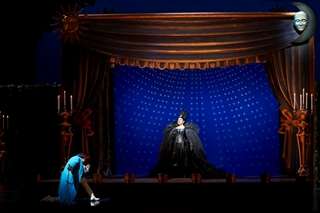|
Back
A Sparkling Delight Toronto
The Four Seasons Centre for the Performing Arts
01/29/2011 - & February 1, 3, 6, 8, 10, 12, 16, 18, 20, 23, 25, 2011
Wolfgang Amadeus Mozart: Die Zauberflöte, K. 620
Isabel Bayrakdarian*/Simone Osborne (Pamina), Michael Schade*/Frédéric Antoun (Tamino), Rodion Pogossov (Papageno), Aline Kutan (Queen of the Night), Mikhail Petrenko (Sarastro), John Easterlin (Monostatos), Lisa DiMaria (Papagena), Betty Waynne Allison (First Lady), Wallis Giunta (Second Lady), Lauren Segal (Third Lady), Robert Gleadow (the Speaker), Neil Craighead (First Priest), Michael Barrett (Second Priest), Gregory Carroll (First Armed Man), Michael Uloth (Second Armed Man
Canadian Opera Company Orchestra and Chorus, Sandra Horst (Chorus Master), Johannes Debus (Conductor)
Diane Paulus (Director), Myung Hee Cho (Set and Costume Designer), Scott Zielinski (Lighting Designer)

M. Schade, A. Kutan (© Michael Cooper)
The Canadian Opera Company’s last attempt at Die Zauberflöte on their main stage was back in 1993 in a production best forgotten. This new staging, directed by Diane Paulus and designed by Myung Hee Cho, is a vibrant delight that audiences will surely enjoy for years to come.
Paulus and her associates have embraced and even enhanced the early performing traditions of the work, at one point the design quoting the famous backdrop designed in 1815 by Karl Friedrich Schinkel for the Queen of Night’s first appearance (see photo above). They have set it as a play within a play, with a “rustic” stage, its mechanical system on view, erected in an aristocratic garden to celebrate a young woman’s name day. She turns out to be Pamina, and other members of the household turn up in various roles. One advantage of this is that many scenes are enlivened by the presence of the onstage audience and its reactions.
For Act II, the stage is wheeled off and the garden’s ever-shifting maze becomes the locus for the rituals and mysteries of Sarastro’s realm.
In spite of the historicist approach to the production, there are some modern (or post-modern) touches. The Queen’s Three Ladies, for example, are done up in a style I can only describe as Sarah-Palin-goes-goth. Equally witty are the monsters that are pacified by Papageno’s chimes. Included here is a dancing alligator (who can resist?) The three-headed dragon is also a hit.
Rodion Pogossov makes a welcome return to the COC and his Papageno is as mischievous and well-sung as his Figaro in Il Barbiere di Siviglia (2008). He also excels in projecting the sometimes-lengthy spoken dialogue. Lisa DiMaria matches him both in spirit and voice as Papagena.
Tamino is one of Michael Schade’s important roles, what with 250 performances and counting. Happily there’s absolutely no sign of staleness in his performance. “Dies Bildnis ist bezaubernd schön” is particularly rapturous and ably sets the mood for the subsequent romantic elements of the plot.
Matching his ardour is Isabel Bayrakdarian, for whom the role of Pamina seems tailor-made.
Aline Kutan’s Queen of the Night might be as well-travelled as Schade’s Tamino and her performance demonstrates exactly why. One of the flaws in the work is that she and her evil cohorts (Monostatos with devil’s horns and tail) are defeated towards the end by a mere thunder clap. I was hoping for a reappearance of the alligator. It turns out they aren’t that evil (or defeated) after all, as they reappear as members of the party celebrating the work’s joyous finale.
Mikhail Petrenko’s opening lines give the impression that his voice is a shade too light and youthful for Sarastro. While he lacks the ultimate sonority we associate with the role, the voice ably descends to the challenging low notes. Robert Gleadow is an eloquent Speaker.
The roles of the Two Armed Men are often given to young singers with notable potential. (Back in 1982 when the COC presented Maurice Sendak's production, they were Ben Heppner and Gidon Saks.) Gregory Carroll sports the serious tone of a budding heldentenor and let’s watch out for Michael Uloth, who will perform Sarastro on Feb. 17.
COC Music Director Johannes Debus conducts yet another well-prepared performance we have come to expect from the company.
There are some interesting cast changes toward the end of the 13-performance run, as well as a performance by members of the COC’s Ensemble Studio on Feb. 17. If you’ve seen this production already it’s well worth a second viewing.
Michael Johnson
|